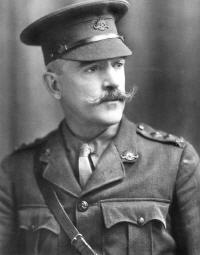
Arthur Streeton was one of Australia's best known landscape painters and member of the "Heidelberg school". Born at Mt Duneed, Victoria, in 1867, he studied at the National Gallery School from 1884 to 1887. He was apprenticed as a lithographer with Troedel and Cooper, Melbourne, until 1888 when he left to take up painting full-time.
During the 1880s Streeton was one of a group of young Australian artists who took up the French tradition of painting outdoors. He produced direct works that were believed to capture the distinctive qualities of the Australian sunlight. Later paintings created images of Australia that were widely regarded as embodying the essence of national character.
Anxious for success overseas, Streeton left Australia for Europe in 1897. When the First World War broke out he was living in London. Since he was too old for military service he joined the Royal Army Medical Corps and worked as an orderly at the 3rd London General Hospital, Wandsworth, alongside other Australian artists, including Tom Roberts, A. Henry Fullwood and George Coates.
After his discharge as medically unfit, Streeton lobbied for the establishment of an Australian war art scheme. He was offered a commission by the Canadian government but declined, preferring to work for Australia. He was appointed an official war artist in May 1918, sent to France and attached to the 2nd Division AIF.
Streeton worked mostly around the Somme battlefields until mid-August 1918, when he returned to London. His drawings, watercolours and paintings show the AIF headquarters at St Gratien, Glisy and Heilly, the dressing stations at Villers-Bretonneaux, landscape studies and scenes of wrecked machinery. In October and November Streeton returned to France, again with the 2nd Division. This time his works concentrated on the destruction around Peronne.
Back in London, Streeton completed his contract as an official war artist with The Somme valley near Corbie, a large landscape showing the opening stages of the second battle of the Somme. With a peaceful rural landscape dominating the foreground and an artillery barrage set in the far distance, the painting embodies Streeton's observation, (in a letter to Sir Baldwin Spencer) that
"True pictures of Battlefields are very quiet looking things. There's nothing much to be seen - everybody & thing is hidden & camouflaged - it is only in the Illustrated papers one gets a real idea of Battle as it occurs in the mind of the man whose never been there".
Streeton returned to Australia in 1920, a famous and popular artist. He was knighted for his services to art in 1937 and died at Olinda, Victoria, in 1943.